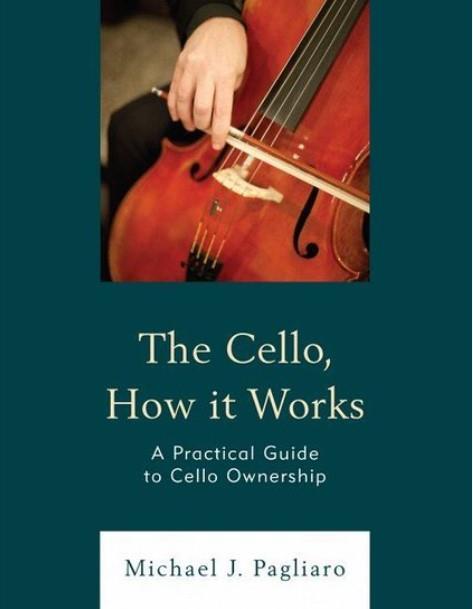Anne Inglis reviews Michael J. Pagliaro’s book, the latest in a series on the workings of musical instruments

The Cello, How It Works: A practical guide to cello ownership
Michael J. Pagliaro
106PP ISBN 9781475869125
Rowman & Littlefield $25
With the odd syntax of the title included, the book is what it says on the tin – a guide to the cello and most of the things it does. This is what we have inside: ten chapters, some of which are divided into lessons to split up the text. Topics include everything from cello wood, analysis of the workings of the bow, home adjustments for the instrument, practice tips and a dictionary for cello students. Let’s open this magical world of the cello and take a closer look.
The book opens with an explanation of scientific pitch notation, with all the Cs written out on the stave and numbered. The workings of the cello are described in chapter one, which is divided into several lessons as new topics are introduced. There is a description of how the sound is made, how to tune your cello, your bow and its parts. Lesson six in chapter one introduces the notion of changing notes, and there are several pages here of an ‘advanced fingering chart’, followed by a ‘basic fingering chart’ (this last a diagram system often familiar from guitar fret identification). Chapter two moves on to caring for your cello, and how to make set-up adjustments yourself. Chapter three embraces the planning of practice sessions, including some pointers to apps to support practice and tuning.
We move on to descriptions of different types of strings and mutes, drawings of bow cases and music stands, and some additional accessories such as polish. The making of cellos is the next subject, and there are photographs of steps in the process and descriptions, some quite detailed. The history of the cello follows in chapter six, schools of making are introduced, and refer to the leading makers of each one. It is now the turn of the bow, and a discussion of bow making is followed by the history of their evolution. There is a dictionary for cello students in chapter nine, and a review of cello parts in chapter ten (information repeated from earlier in the book). Throughout there are useful photographs.
Apart from the history, the cello is treated in isolation and isn’t linked to the wider violin family, so reading this book it does seem as though the cello is a strange, isolated beast. Where it does have a past, we find that its history is allied to the viol, a link that is usually discredited in contemporary thinking, but I liked the description of plucked instruments, and it isn’t always the case that bows are given their due in pages of analysis.
Book review: Highway Cello
Book review: Top Secrets for Cellists: An Organized Method of String Playing
Book review: The Secret of Technique in Cello Playing
I worry about the inclusion of ‘making minor adjustments’. Although this includes tips on treating slipping pegs, it also mentions adjusting the bridge position. Elsewhere, there is detail on ‘successful tuning’, including the instruction: ‘It is very important you force the pegs into the red holes. If you just turn the peg , it will not hold the string in tune.’ Well, yes, all these points are true, but for beginner cellists, these aspects are always delegated to someone who carries some playing or teaching experience. No child should be encouraged to tune like this, or move the bridge. This brings me on to wondering who the book is for.
My take-home from this cello analysis is that its very breadth and detail make it the perfect book for a school project on the cello, or for a keen young player wishing to look a little further. Adults might be interested. Anyone who really knows about instruments will find the content too basic, and the playing charts look indigestible even if useful. Anyone who knows too little is unlikely to think, ‘Aha, this is the book to support my G major scale.’ But it could be good for the serious cello student who wishes to know some more.
It is a pity that the ultimate aim of playing the cello – to play music – isn’t addressed in a chapter on repertoire. It would have been interesting to have at least a list of cello concertos, sonatas, solos in the symphonic repertoire or a mention of string quartets with notable contributions for the cello.
The prose is lucid and the explanations clear. The illustrations and photographs supplement the text, and are especially detailed regarding the making process. The book is in black and white, with a good colour cover showing a perfect cello bow hold. The book is co-published in partnership with American organisation the National Association for Music Education.
ANNE INGLIS











































No comments yet